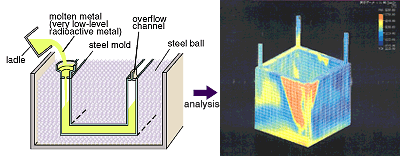In the dismantling of nuclear facilities, a large amount of very low-level
radioactive scrap metal and a small amount of high-level radioactive
waste arise at the same time. For packaging the high-level radioactive
scraps, thick metal wall containers are used for shielding. If the container
is molded out of very low-level radioactive metal, it causes effective
recycling of the waste scraps. In this case, the fabrication of the
container with contaminated metal should not give rise to additional
radioactive wastes and the container itself needs to have sufficient
strength.
The focus point of this technology is to use steel balls as heat sink
and dissipater, and thin non-radioactive steel wall molds. The steel
wall molds are filled with very low-level radioactive metal and become
a part of the integrated container, in which high-level radioactive
waste is cast. The developed method leads to much less contamination
compared to the method using sand molds.
The proper combination of the size of steel balls and their packing
density which gives 4 to 5 times larger heat conductivity than that
of a sand mold (less than 1/10 of that of steel) with the proper temperature
of molten metal and its pouring speed (selected by referring to the
experimental results and the theoretical calculation), led to the success
of the trial production of a container with enough strength and without
casting defects.
Generally, for packaging highly radioactive waste, the applicability
of this method may be very promising, since the weight of container
becomes ten to several tens of times larger than that of the waste content. |

